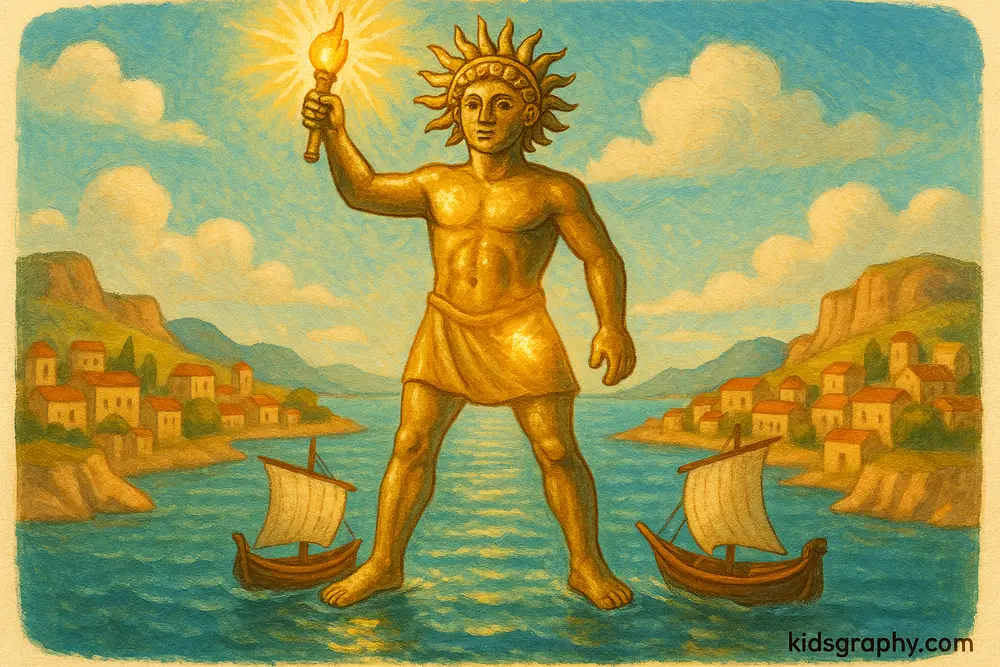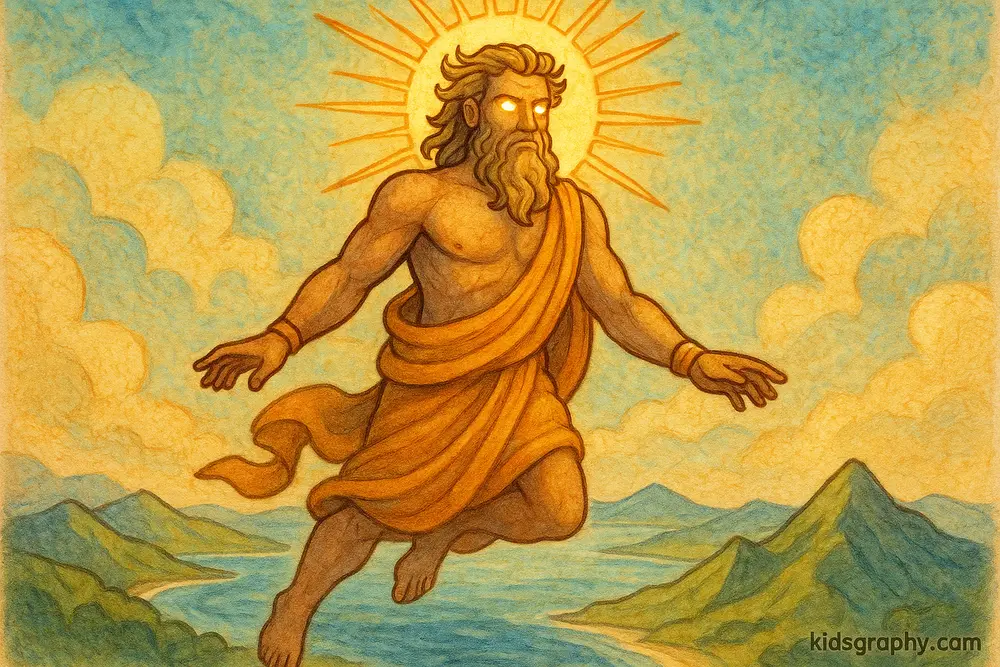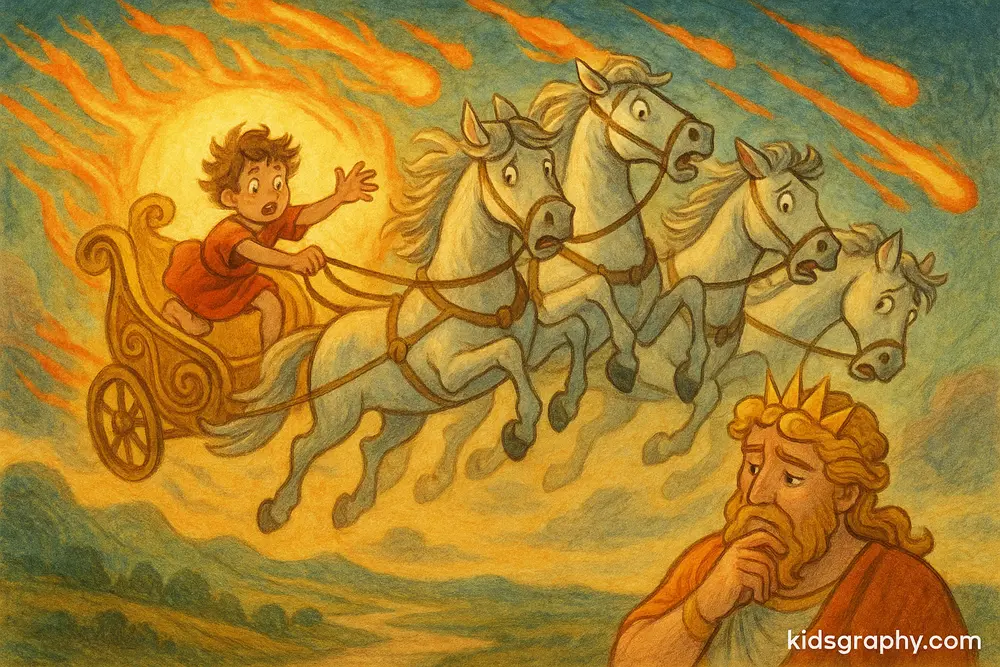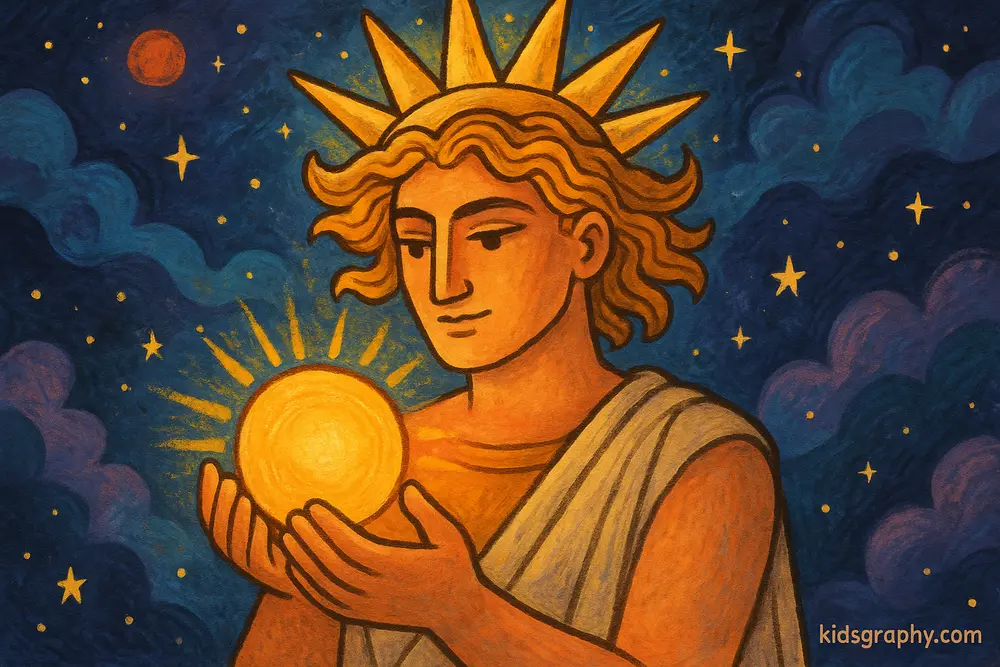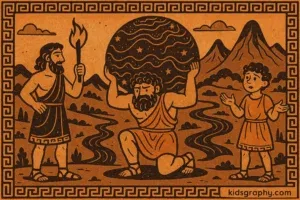In ancient Greek mythology, when people looked up at the sun rising and setting each day, they believed it wasn’t just nature—it was a divine journey. That journey was led by Helios, the brilliant and powerful sun god of Greek mythology.
Let’s explore who Helios really was, what made him so unique, and how his story continues to shine through history.
Read More: Calypso Greek Mythology: The Lonely Nymph
Who Is Helios in Greek Mythology?
Helios was the Titan god of the sun, born to the Titans Hyperion and Theia. He had two sisters—Selene, goddess of the moon, and Eos, goddess of the dawn.
Every day, Helios rose from the east in a golden chariot and drove across the sky, bringing light to the world. At night, he sailed back across the ocean in a giant golden cup to start again the next morning.
Helios was often shown as a handsome man with a shining crown of light, guiding four fiery horses named Pyrois, Eos, Aethon, and Phlegon.
Read More: Circe in Greek Mythology: The Witch of Aiaia
Helios’ Chariot and Daily Journey
One of the most famous images of Helios is him riding his sun chariot across the sky. The chariot was made of gold and fire, and its wheels never touched the ground.
His journey marked the passage of time, and the ancients believed sunrise and sunset were caused by his daily ride.
In artwork, he was shown with a radiant halo, often in a powerful stance as he guided his horses over the earth. The Greeks saw Helios as a witness to all things, since he could see everything from the sky.
This made him a god of truth and oaths too.
Read More: Ajax in Greek Mythology: Warrior of Honor and Tragedy
Helios vs. Apollo: Are They the Same?
Many people get confused between Helios and Apollo. In early Greek myths, Helios was the original sun god, while Apollo was the god of music, prophecy, and healing.
Over time, especially in Roman and later Greek stories, Apollo began to take over Helios’ role as the sun god. That’s why some stories call Apollo the driver of the sun chariot.
But in classical mythology, Helios and Apollo were separate gods, each with different powers and stories.
Read More: Hera in Greek Mythology: Queen of the Gods
Helios and Phaethon: A Cautionary Tale
One of the most dramatic stories involving Helios is the tale of his son, Phaethon.
Phaethon wanted proof that Helios was his father. To prove it, Helios promised to grant him any wish. Phaethon asked to drive the sun chariot for a day.
Helios warned him it was too dangerous, but a promise was a promise.
Phaethon climbed into the chariot but couldn’t control the fiery horses. He flew too high, freezing the earth, and then too low, burning it. To save the world, Zeus struck him down with a thunderbolt.
This myth explains deserts, ice caps, and sunburn, and teaches about pride, recklessness, and the limits of power.
Read More: Chaos in Greek Mythology: The First Being of Creation
The Powers of Helios
Helios was more than just a light-bringer. His powers included:
- Vision over all the earth from the sky
- Control of fire and solar energy
- Truth-speaking—he saw everything and couldn’t lie
- Healing in later versions of the myth
He was respected by gods and mortals alike, and his name means “Sun” in Greek.
Read More: Typhon in Greek Mythology: The Father of Monsters
Worship and Legacy of Helios
Though not as widely worshipped as Zeus or Apollo, Helios had temples and cults, especially on the island of Rhodes. The people of Rhodes even built one of the Seven Wonders of the Ancient World in his honor—the Colossus of Rhodes, a giant bronze statue of Helios.
In art, Helios continued to appear through Roman times and into the Renaissance as a symbol of light, power, and clarity.
Today, he’s still featured in fantasy stories, video games, and literature as the original sun god of the Greek world.
Read More: Pandora in Greek Mythology: The First Woman’s Curse
Symbolism of Helios in Greek Mythology
Helios isn’t just a character in myths—he stands for light, vision, and unstoppable truth. The way he watched the world from his chariot made him a cosmic observer, one who could see everything mortals and gods did.
That’s why Helios became:
- A symbol of truth—people swore oaths in his name.
- A symbol of time and renewal—his daily ride marked the cycle of days.
- A symbol of cosmic balance—his journey kept day and night in order.
In ancient philosophy, Helios also represented the mind’s ability to bring light to darkness, helping people see truth clearly.
Read More: Persephone in Greek Mythology: Queen of the Underworld
Artistic Depictions of Helios
Ancient Greek artists often portrayed Helios as a handsome, radiant god with a glowing halo or rays shining from his head.
You might find him:
- Driving his chariot across a mosaic sky
- Rising from the ocean at dawn
- Standing with a globe or torch
Later Roman art merged Helios with Sol, the Roman sun god, but still kept his fiery aura and powerful horses.
The most famous artistic tribute was the Colossus of Rhodes—a massive statue of Helios that stood at the harbor of Rhodes and welcomed travelers from all over the ancient world.
Read More: Athena in Greek Mythology: Goddess of Wisdom & War
Helios Across Mythologies
Helios’s story echoes the sun gods of other cultures:
- In Egyptian mythology, Ra sails across the sky in his solar boat.
- In Hindu mythology, Surya rides a chariot pulled by seven horses.
- In Norse mythology, the sun is chased by a wolf and pulled by Sól, a sun goddess.
These comparisons show how ancient cultures all saw the sun as a divine force, with Helios being one of the earliest and most vivid portrayals.
Read More: Perseus in Greek Mythology: Hero, Slayer of Medusa
Modern Culture of Helios
Helios still shines in modern books, games, and shows. You’ll find him in:
- Rick Riordan’s books, where he’s sometimes confused with Apollo.
- Video games, like God of War and Assassin’s Creed Odyssey.
- Space science, where “Heliosphere” refers to the sun’s protective bubble around the solar system.
Even today, names like Helios Energy or Project Helios show how this ancient god still symbolizes light, power, and endless motion.
More Stories: Helios in Greek Mythology
FAQ: Helios in Greek Mythology
Helios is the ancient Greek sun god, known for driving a golden chariot across the sky each day to bring sunlight to the world.
Helios had the power to control sunlight, see everything on Earth from the sky, and serve as a divine witness to truth and oaths.
No, Helios and Apollo were originally separate gods. Helios was the Titan sun god, while Apollo was a later Olympian god of music and prophecy.
Phaethon tried to drive Helios’s sun chariot but lost control, causing destruction. Zeus struck him down with lightning to save the world.
Yes, especially on the island of Rhodes, where people built the Colossus of Rhodes—a giant statue of Helios—in his honor.
